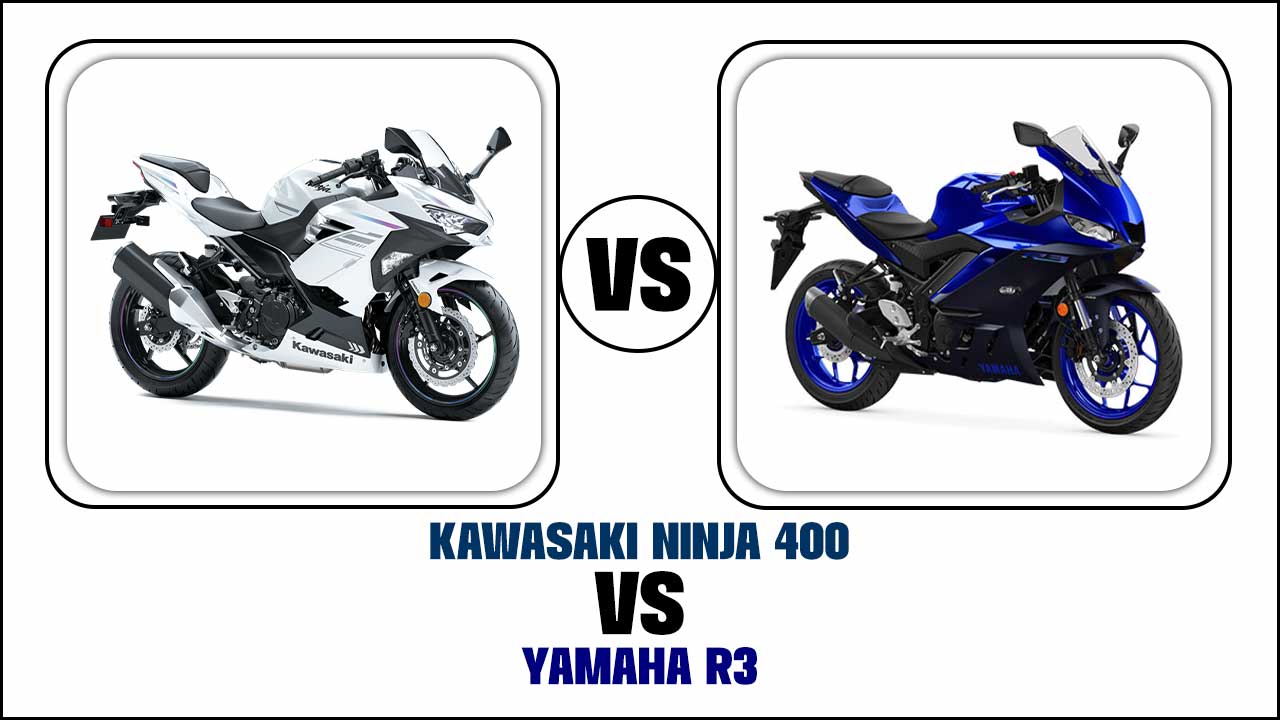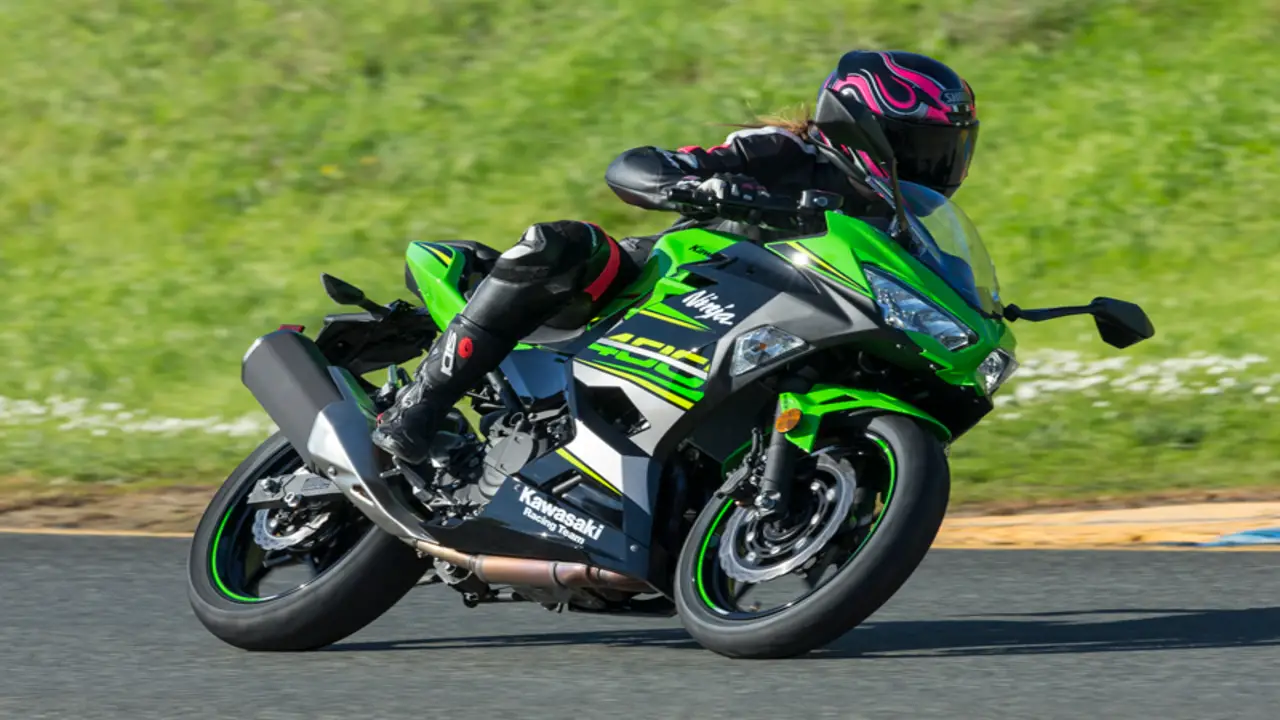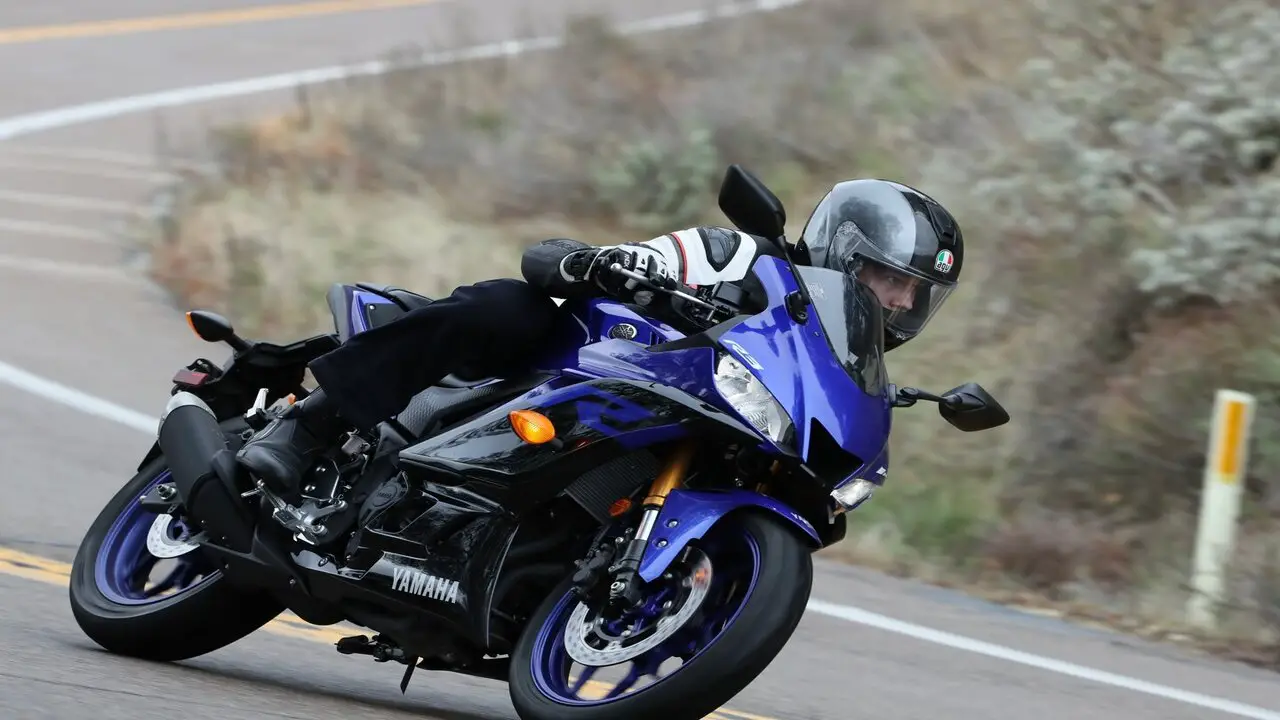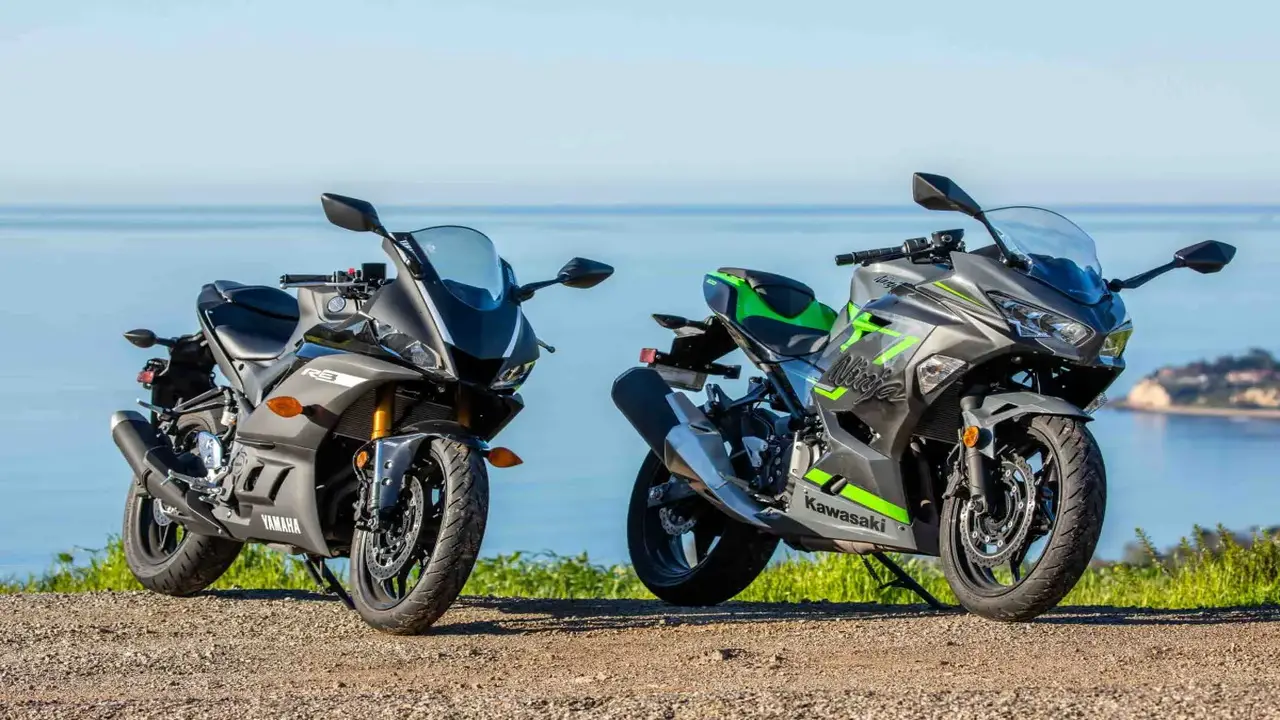The Kawasaki Ninja 400 vs Yamaha R3 are two popular motorcycles that have gained a loyal following among riders. Both models are designed to balance performance and affordability, making them great options for those who want a thrilling ride without breaking the bank.
The Ninja 400 boasts a powerful engine and sleek styling, while the R3 offers agile handling and a sporty design. Choosing these two bikes can be tough whether you’re a seasoned rider or starting. But which one should you choose? Here, we’ll compare these two superbikes, covering everything from their max torque to ignition and fuel.
We’ll also examine their motor performance, riding experience, design and aesthetics, and key differences. Additionally, we’ll compare these bikes with some of their alternatives so that you can make an informed decision based on your preferences.

Kawasaki Ninja 400 Review

The Kawasaki Ninja 400 is a powerful and agile sportbike highly regarded by gear enthusiasts. Kawasaki manufactures this bike with impressive performance and handling capabilities, making it a popular choice among experienced riders.
The Ninja 400 features high-quality tyres that provide excellent grip on the road, ensuring a smooth and controlled ride. It falls under the class of lightweight sportbikes, which makes it ideal for those who enjoy quick acceleration and nimble manoeuvrability. Overall, the Kawasaki Ninja 400 is a top contender in its class, offering an exhilarating riding experience for those seeking speed and precision.
Features
- Lightweight Design
- ABS Braking System
- Slipper Clutch
- Digital Instrument Cluster
- LED Lighting
- Adjustable Suspension
- Assist and Slipper Clutch
- Aerodynamic Fairing
- Fuel Efficiency
Specifications
- Engine: Liquid-cooled, 4-stroke parallel twin engine
- Displacement: 399cc
- Power Output: 45 horsepower
- Torque: 28 lb-ft
- Transmission: 6-speed
- Fuel System: Fuel injection
- Frame: Trellis, high-tensile steel
- Suspension: Front telescopic fork, rear mono-shock
- Brakes: Front and rear disc brakes
- Weight: 366 lbs (166 kg)
Pros:
- Performance
- Handling
- Fuel Efficiency
- Comfort
- Technology
Cons:
- Seat Height
- Wind Protection
Yamaha R3 Review

The Yamaha R3 is popular among street bike enthusiasts, offering a sleek and sporty design. It features fuel injection for efficient fuel delivery and a fuel indicator to help you keep track of your fuel levels. With an average user rating of 4.5 out of 5 stars, it is clear that many riders are satisfied with the performance and reliability of the Yamaha R3.
The Yamaha R3 boasts a budget road tyre with exceptional grip, a sleek caliper design, and smooth performance in its 5th gear, all offered at affordable prices, making it the perfect choice for American riders. Additionally, this bike is equipped with liquid cooling, which helps to prevent overheating and ensures optimal engine performance even in challenging conditions.
Features
- Design
- Suspension
- Smooth Braking system
- Instrument cluster
- LED Lighting
- Ergonomics
- Traction Control System
- Fuel efficiency
Specifications
- Engine: 321cc, liquid-cooled, inline twin-cylinder engine
- Power: 42 horsepower
- Torque: 29.6 lb-ft
- Transmission: 6-speed manual
- Frame: Diamond-type steel frame
- Suspension: Front telescopic fork, rear mono shock
- Brakes: Front and rear hydraulic disc brakes
- Tires: Front 110/70-17, rear 140/70-17
- Fuel Capacity: 14 litres (3.7 gallons)
- Weight: 166 kg (366 lbs)
Pros:
- Power and Performance
- Handling and Control
- Stylish Design
- Affordability
- Fuel Efficiency
Cons:
- Limited Top Speed
- Lack of Wind Protection
Kawasaki Ninja 400 Vs Yamaha R3: Which Bike Should You choose?

The Kawasaki Ninja 400 vs Yamaha R3 are popular for those looking for a sporty and reliable bike. Regarding torque, the Kawasaki Ninja 400 has a slight advantage over the Yamaha R3. With a torque of 28 Nm at 8,000 RPM, the Ninja 400 provides strong acceleration and power throughout its range.
In terms of power, the Yamaha R3 has a torque of 22.6 Nm at 9,000 RPM, which is still impressive but not quite as high as the Ninja. Performance-wise, both bikes offer excellent handling and are great options for thrilling rides. Choosing between these two bikes will ultimately depend on personal preference and specific riding needs. However, it is important to take into consideration the wheels, bike history, bike ownership experience, brake pad material, and overall brake performance based on the Brake Type before making a decision.
| Specification | Kawasaki Ninja 400 | Yamaha R3 |
| Engine | 399cc, parallel twin | 321cc, parallel twin |
| Power | 49 horsepower | 42 horsepower |
| Torque | 28 lb-ft | 21 lb-ft |
| Transmission | 6-speed manual | 6-speed manual |
| Weight | 366 lbs | 368 lbs |
| Suspension | Telescopic front, monoshock rear | Telescopic front, monoshock rear |
| Brakes | Front and rear disc brakes | Front and rear disc brakes |
| Fuel Capacity | 3.7 gallons | 3.7 gallons |
| Seat Height | 30.9 inches | 30.7 inches |
| Price | Starting at $5,399 | Starting at $5,299 |
Comparison Of Engine Specification
Both bikes have a lot to offer regarding the engine and performance of the Kawasaki Ninja 400 and Yamaha R3. The Ninja 400 boasts a 399cc parallel-twin engine that produces around 49 horsepower. It also has a six-speed transmission and a top speed of around 105 mph. On the other hand, the Yamaha R3 has a slightly smaller 321cc engine but still manages to produce around 42 horsepower.
It also has a six-speed transmission and can reach a top speed of around 110 mph. Both bikes offer smooth handling and responsive acceleration, making them great options for anyone looking for a sporty ride. Ultimately, the decision between these two bikes will come down to personal preference and riding style.
Comparison Suspension And Chassis

The suspension and chassis of the Kawasaki Ninja 400 and Yamaha R3 are designed to provide a comfortable and stable ride. The Ninja 400 features a steel trellis frame, while the Yamaha R3 has an aluminium delta box frame. Both bikes have telescopic front suspension and swingarm rear suspension, providing excellent handling and control on the road.
The Ninja 400’s suspension is adjustable, allowing riders to fine-tune their ride for optimal performance. However, the Yamaha R3 has a slightly lighter weight and more compact design, making it easier to manoeuvre in tight spaces.
Comparison Of Bike Colours
When comparing the Kawasaki Ninja 400 and Yamaha R3, bike colour is not typically a top consideration. Both bikes offer a range of colours, with options like black, blue, and green. While personal preference may play a role in the colour someone chooses, it is important to focus on other factors such as performance, handling, and price when deciding between these popular sports bikes.
So whether you prefer the sleek look of the R3 in matte black or the bold green of the Ninja 400, remember that choosing a bike based solely on its colour is not always the best approach.
Comparison Of Motor And Performance
The Kawasaki Ninja 400 and Yamaha R3 are popular sports bikes offering impressive motor and performance capabilities. The Kawasaki Ninja 400 features a liquid-cooled, fuel-injected engine that delivers 49 horsepower, while the Yamaha R3 boasts a liquid-cooled, fuel-injected engine that delivers 50 horsepower. Both bikes have a top speed of around 110 mph and can go from 0 to 60 mph in just over five seconds.
Regarding handling, the Yamaha R3 is known for its agility and nimble steering, while the Kawasaki Ninja 400 offers excellent stability and control at higher speeds. Ultimately, the choice between these two bikes will come down to personal preference and the type of riding experience you seek.
Riding Experience With The Kawasaki Ninja 400 And Yamaha R3

One must note several key differences when considering the riding experience of motorcycles like Kawasaki Ninja 400 and Yamaha R3. These two bikes offer different riding positions; while the YZF-R3 provides a comfortable stance, the Ninja 400 offers an aggressive one. However, these machines provide similar levels of horsepower. There are distinct differences in torque output, transmission, and clutch smoothness.
The championship class battle between the Kawasaki Ninja 400 and Yamaha R3 showcases their type pin code of performance and the all-new bike engine performance, delivering an exhilarating riding experience that impresses even the most discerning Cycle World enthusiasts.
Riders will find that R3’s smoother transmission makes it easy to handle, while Ninja 400’s higher torque output allows for better acceleration at lower RPMs. Additionally, the Kawasaki Ninja 400 has superior brakes and suspension, which enable a sportier ride, while the Yamaha R3’s softer suspension makes it suitable for touring riders who value comfort.
Price Comparison
Regarding the entry-level sportbikes segment, two popular options are the Kawasaki Ninja 400 and the Yamaha R3. These bikes are often compared for their similar engine sizes and power outputs, but there are some significant differences in pricing. When writing, the Kawasaki Ninja 400 has a starting price of $4,999, while the Yamaha R3 starts at $5,299.
Although the price difference may seem negligible, it’s important to note that it can significantly impact a buyer’s budget. Regarding features, both bikes offer a range of modern amenities, including ABS and slipper clutches. The Kawasaki Ninja 400, however, has a larger fuel tank capacity, allowing for longer rides without refuelling. The Kawasaki Ninja 400 also boasts a slightly higher horsepower output, making it marginally faster on the track.
Reasons To Choose Kawasaki Ninja 400 Over Yamaha R3

When choosing between the Kawasaki Ninja 400 and the Yamaha R3, there are a few reasons why you might prefer the Ninja 400. Firstly, the Ninja 400 has a larger engine size, which can give you more power and acceleration on the road. Additionally, the Ninja 400 has a slipper clutch, which can make downshifting smoother and less jarring.
The Ninja 400 also has a slightly higher seat height, which can be an advantage for taller riders who want more legroom. Finally, some riders prefer the look and feel of the Kawasaki brand over Yamaha. Ultimately, the decision between these two bikes will come down to personal preference. And the features most important to you as a rider.
Conclusion
Comparing the Kawasaki Ninja 400 vs Yamaha R3, both bikes have strengths and weaknesses. The Ninja 400 is a great all-around bike with a smooth engine, comfortable ergonomics, and user-friendly features. On the other hand, the Yamaha R3 is a more focused machine with a racing-inspired design and sharp handling.
Both bikes offer excellent value for their respective price points, and riders looking for a lightweight, entry-level sportbike would do well to test ride both and choose the one that best suits their needs and riding style. Choosing these two bikes will ultimately depend on your preferences and riding style. Whether you choose the Ninja 400 or R3, both offer an exhilarating ride and are great options for anyone looking to get into sport biking.
Frequently Asked Questions
Is A Ninja 400 Faster Than An R3?
The Ninja 400 is generally considered faster than the R3, with a higher top speed and more horsepower. However, the performance can vary depending on the rider’s skill and conditions.
Is The Ninja 400 Fast?
Yes, the Ninja 400 is considered to be a fast motorcycle. It has a top speed of around 105 mph and can accelerate from 0 to 60 mph in about 5 seconds.
Is Ninja 400 A Superbike?
No, the Ninja 400 is not considered a superbike. It falls into the category of sports motorcycles or entry-level sportbikes. Superbikes typically have higher engine displacements and more advanced features for performance riding.
Is Yamaha R3 Good?
Yes, the Yamaha R3 is considered a good motorcycle. It offers a powerful engine, agile handling, and a comfortable riding position, making it suitable for beginners and experienced riders.
Is Ninja 400 Or R3 Better?
Both the Ninja 400 and R3 are great options for entry-level sports bikes. The Ninja 400 offers more power and torque, while the R3 is known for its nimble handling.
